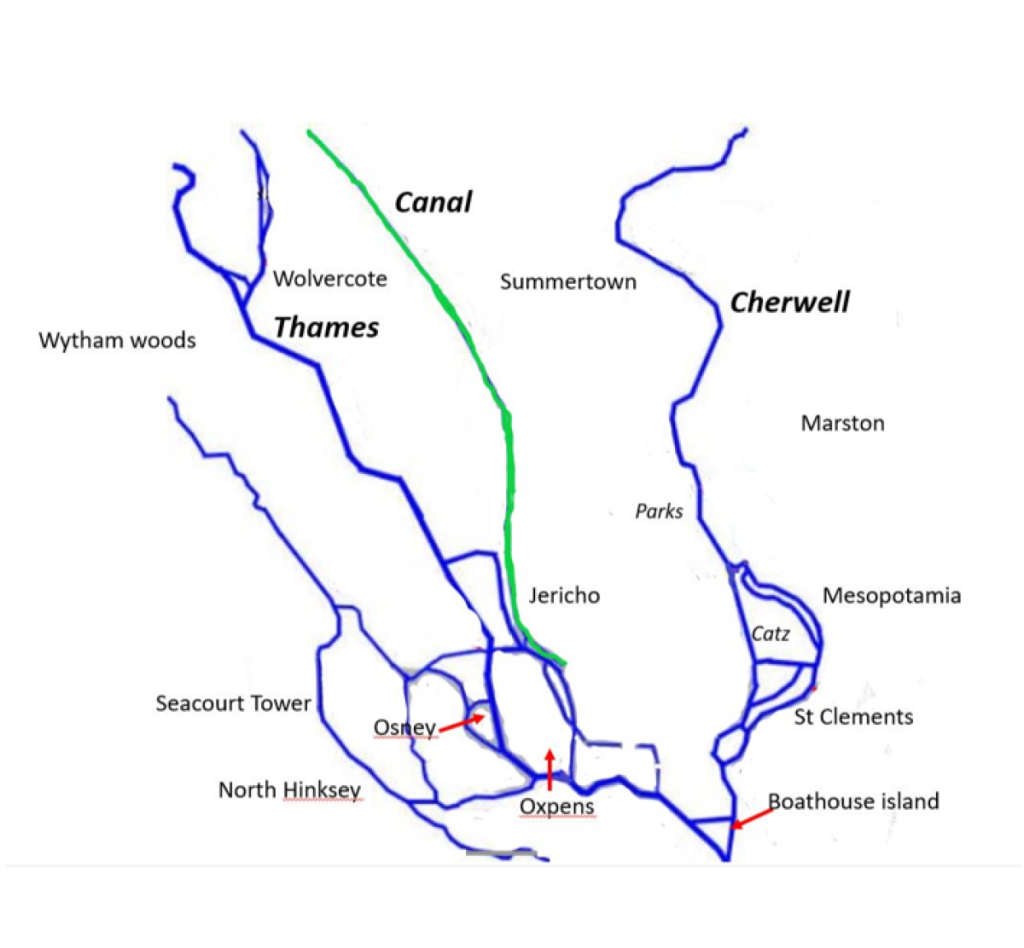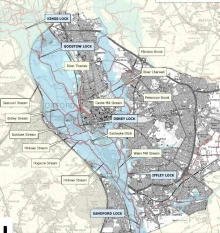The city of Oxford is traversed by two rivers and a canal.
The two rivers drain the Cotswolds. Thames flows from Thames Head in Gloucestershire through London to the North Sea at the Nore (ie roughly west-east). The Cherwell flows from near Hellidon in Northamptonshire to Oxford (ie roughly north-south). The canal also runs roughly north-south, but through more of the industrial midlands, starting from the Coventry canal, in Warwickshire, and passing through Leamington Spa and Banbury to Oxford. The canal was completed in 1790.
The Thames and the Cherwell are both described as braided rivers, rivers which split and rejoin repeatedly. And have done for millennia. According to an archaeological survey of the Thames Valley: ‘The modern Thames has been subtantially channelized by dredging, embanking and the insertion of locks and weirs for navigation. It has also experienced much natural silting, which has tended to simplify a complex system of linked multiple channels (an anastomising system) to a single channel. However, along part of its length, for example at Oxford, a complex channel system survives’.

The map above traces the main rivers and streams from roughly the ring road in the north to the junction of the rivers in the south. It captures the main strands in the braiding, but not the full tracery of streams and ditches which criss cross the floodplain and beyond.
The Cherwell is relatively austerely braided, most evidently between the University Parks and St Clements. Mesopotamia is so named because it lies between two rivers, like the Tigris and Euphrates, some old donnish joke. But in the case of this Mesopotamia, both these rivers are the Cherwell.
The Thames is crazily fissiparous, especially in the space between Jericho, Seacourt Tower, North Hinksey and Oxpens. Around Oxpens, it was once more fissiparous. A city heritage assessment says of this area: ‘by the Late Bronze Age to Early Iron Age much of St Aldates consisted of an extensive reed swamp with braided channels that stretched from Osney Island to Christ Church Meadow, creating a series of islands between the later Southgate and the Hogacre Ditch. By the Roman period the deposition of alluvial clay gradually began to infill much of this drowned landscape. Nevertheless in the medieval period significant land reclamation was required to enable the expansion of the southern suburb’.
A geological assessment explains that the sprawl was encouraged in the first instance by the base being Oxford Clay. By Sandford, to the south, the river hits an area of Corallian limestone (the rock that underpins the western hills by Cumnor and Wytham). Here the floodplain narrows.
What is and isn’t an island amidst this mass of braidings is a matter of perception. The -ey element in numerous Oxford place names (Hinksey, Binsey, Osney) identifies these as raised ground, that would stand above the waters in a flood — though the long process of land reclamation means they don’t look like islands now. Osney Town and Boathouse island are by contrast now described as islands, no doubt because of the relatively small space enclosed by the waters: they are experienced as islands. ‘Eyot’ or ‘Ait’ (incorporating the -ey element) sometimes survives as a name for islands created by sediment in the Thames, though not all such are commonly called such. Mesopotamia is an ait, as is Fiddler’s Island.
Aston’s Eyot, just south of Boathouse Island, preserves the name. Aston’s Eyot once had more the feel of an island, because one branch of the Cherwell flowed behind it, to enter the Thames a few hundred yards along, through the Shire Lake Ditch. But in the 1880s, a ‘New Cut’ designed to relieve flooding in Christchurch Meadows cut a wedge between (what by this process became) Boathouse Island and the Eyot, reducing the flow through what became a more ditch-like ditch, and making the Eyot’s island status notional.

Revised in the light of my geological and archaeological reading.

One thought on “Two braided rivers”